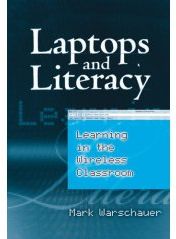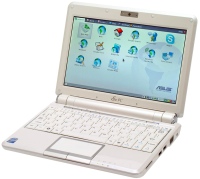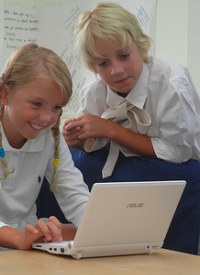A few years ago, I carried out a two-year study of one-computer-per-student laptop programs in U.S. schools. Our research team investigated ten schools in California or Maine in which all students in one or more classes were provided laptop computers for use throughout the school day and, in most cases at home.
Our research drew on 650 hours of classroom observation; 150 interviews with teachers, students, and parents; surveys of a thousand students and teachers; examination of student work and records; and analysis of test score results in several of the schools.
The results of the study -- reported in my book, Laptops and Literacy, and in a number of papers available on my Website - discussed the positive findings of this research. The overall summation could be described as follows:
Laptops make a good school better, but they don't make a bad school good.
They make a good school better by facilitating more and higher quality writing, allowing the practice and development of 21st century learning skills, encouraging high student motivation and engagement, and assisting effective integration of technology in teaching and learning. (They don't make a bad school good, because if teachers and students are invested in wasting time rather than learning, an Internet-connected computer provides ample opportunities for doing so!)
Following these positive results, I've been frustrated by the slow progress in moving toward more one-computer-per-student programs in the U.S. The main reason for this slow movement is cost. In the last couple of years, I have thus become very enthusiastic about the potential of low-cost netbooks using open source software to overcome the cost factor. I also believe that netbooks are optimized in other ways for education (e.g., size, battery life.) I include within my interests the xo computer, though I have not yet witnessed it being used in instruction. I couple of years ago I observed an early pilot program with the ClassMate PC, which I reported here on OLPC News.
I'm now in the early stages of a research project on netbooks and open source software in U.S. schools. As part of that project, I've been making contact with districts running programs with netbooks, which in all cases have been either the ASUS Eee or XO.
Today, I was able to carry out a full day of observations and informal discussions in Saugus Union School District, which has provided ASUS Eee PC 901 Linux computers to all 1700 of its fourth grade students in a project titled SWATTEC.
I visited six classrooms in three elementary schools in Saugus for about a half-hour each. Classrooms included regular fourth grade students, students in the Gifted and Talented Education program, students in the Special Education Program, and students classified as English Language learners. I wandered around the classrooms freely during observations, and spoke to students and teachers during and after classes.
Students were engaging in similar learning activities that we had witnessed in our earlier laptop research. They were writing and revising papers, creating multimedia presentations, conducting online research, and using the automated writing evaluation program, MY Access. Other than the last program, which is accessed online for an annual fee per student, all the other software used in the project is free and most of it open source. The amount of available software is impressive.
The 901 Linux model has an 8.9" screen, weighs about 2.5 pounds, and has a 1.6 GHz Intel Atom N270 Processor, 1 GB RAM, 20 GB Solid State Drive, Linux, and a 6 Cell Battery with about 4-6 hours of battery life. Those seemed to me to be the right features for elementary and middle school education (high school students would probably want a slightly bigger screen and keyboard). The price - currently $275 retail on Amazon and presumably cheaper for a large order purchased through a distributor - is pretty good too.
I thus began the day with the hypothesis that the Eee 901 Linux is very well suited for K-8 education in the U.S., and my observations and conversations today strengthened that belief. The students got used to the small keys and screen easily, and the battery life is great for schools.
The small size of the laptop makes it less intrusive for other forms of interpersonal interaction, even when open, and it is also small enough to allow students to use the laptop together with paper or a book even on a small student desk.
Teachers reported that the performance of the computers was excellent, and they noted no real differences in performance between these computers and more powerful computers their students have previously used. The laptops should be powerful enough for any typical educational computing function I can think of other than video editing.
All the teachers and students were highly enthusiastic. From everything I could gather, this was a fairly typical representation of fourth grade teachers in the district. None I spoke to were outright technophobes, but they were not technophiles either. All (and some after initial skepticism) had become very positive about the mini-laptops, as they are called there.
Common themes reported in my discussions with teachers were that learning became more autonomous, students had access to a greater range of information and resources, and students wrote and edited more. Students were also very excited about the laptops, not surprisingly. The only problem that teachers reported, other than some minor printing glitches, is that the students "don't want to go to fifth grade," because the grant-funded netbook program, thus far, is only in the fourth grade in the district.
The Special Education teacher was especially enthusiastic. She explained that working with the computers helped build confidence among her students and leveled the playing field for them. She also reported that her students increased their cooperative communication with other students in the school, based on interaction around their common interests in the computers.
The day confirmed my belief in the value of netbooks in schools, and in the Eee 901 in particular. Everything I heard and saw was almost identical to what we heard and saw in my prior research on much more expensive laptop systems in schools. I thus came away with renewed excitement about the potential of netbooks to facilitate improved teaching and learning in America's K-12 schools. (Note: I am not so enthused about the idea of one-computer-per-student programs in developing countries, for reasons similar to those expressed by Atanu Dey.)
In the coming year, I hope to do begin more in-depth investigation of the use of Eee PCs in teaching and learning, and also being similar research in U.S. schools using the XO.
Postscript: After my observations, I heard that this particular model - the 901 with solid state drive - is being publicly phased out, though will still be available for special order by schools. It appears that Asus may be shifting away from 9" screens, Linux, and solid state drives. If that's true, it's unfortunate, and will leave this important sector of the market to others.





While I love my Acer One, I doubt netbooks are good for children. Some things are missing:
+They are not read-friendly.Expecting Pixel Qi to change that(resolution and no backlight).
+Batteries are weak(same solution, pixel qi)
+They have keyboard.(Sorry is not "natural" to type on a computer, give me voice and handwriting recognition).This is going to change soon too.
Once this problems are solved, computers will be way more useful to learn than today.
Thanks for your reply. This particular ASUS model has a 6-cell battery with a 4-6 hour battery life. Could be better, but that's sufficient for U.S. schools. Also, as a professor of literacy, I believe that a keyboard has important affordances for writing and editing that other interfaces lack. And I see no problem with a 10-year-old child learning to keyboard.
I agree. The battery life of our Asus laptops is perfectly adequate and lasts the amount of time required for usage in the school day. Three of our classes now have mini laptops that they take home and, similarly to the children you observed, our year 6 children are not happy about moving to highschool without them.
P.S. (In response to gaia gold - our year 3s (age 7-8) can't wait to get their hands on the mini laptops too!)
My ongoing frustration with ICT in education is that at some level it hasn't evolved since my youth where we'd truck off to the computer lab (full of green-screened Apple IIe systems) to type in our (handwritten) reports (in ALL CAPS) and sneak some time playing Oregon Trail or playing with LOGO or BASIC (I was a geek then as well as now). Excepting in the hands of great teachers and administrators/curricula developers, the computers are tokenized and wedged in to existing curricula. The 901 (and the OLPC) are both excellent systems with sufficient battery life and computational gumption to be useful and flexible educational (and divide-bridging) tools.
PS - I wrote a summary/review of Laptops and Literacy for OLPCNews here:
http://www.olpcnews.com/commentary/academia/laptop_programs_in_america.html
I highly recommend it and Mark's earlier work; Technology and Social Inclusion for ... well, if you're reading OLPCNews, those books should be on your shelf.
Yes, Jon, I very much agree. And thanks for reminding me/us about that nice review you wrote.
Thanks very much for this informative review of these machines in schools. It will be interesting to see the potential of netbooks unfold over the next two years as we see these smaller machines become more powerful (like their big cousins) and even more power-efficient. As an educator, it's hard to balance the gut feeling to want to 'jump right in' with the more cautious, conservative approach of 'wait and see.' Still, it's exciting to see the rise of netbooks globally and wonder how quickly effective schools will pick them up.
Cheers,
M
Mark, thank you for the post. It is interesting that in our country (Russia) Asus EEE PC is the main one-on-one solution. In the last school year over 51 000 Russian elementary school students received those netbooks. The project is financed by a charity foundation called "Volnoye Delo". Although we see here very little evidence of the use of open source products. It is Windows XP + Microsoft Office + licensed educational software. Still it would be interesting to exchange experience with the Saugus school districts teachers about their ASUS experience.
Hi @ all, hi Mark.
First i wanna thank you for this post. Its an informative review of these machines in schools.
For me it´s intresting to see the chance of notebooks... in the next yerars i think media are all over us. Notebooks will become more powerful.
Hmmm I'm curious about it.